Wildflowers for Bees And Pollinators: Thistles
As a wildflower, there are few that can surpass thistles in their value for bees and pollinators. So, if you want to photograph bees and other pollinators, find a patch of thistles growing on a grassy verge or brownfield site. On a sunny day, you will surely have plenty of opportunities. Hopefully, you'll be better with your camera than I!
Admittedly though, these prickly-leaved plants are rarely a welcome sight in the garden for humans! Farmers don't seem too keen either. In particular, some thistle species are considered invasive, especially in some countries.
For a few years now, they have kept making an appearance in our front lawn. If they get into your garden, they can be difficult to get rid of, and it may not be something you really want in your garden, regardless of their attractiveness to bees. Still, the bees around my region have plenty of opportunity to forage on the thistles growing wild.
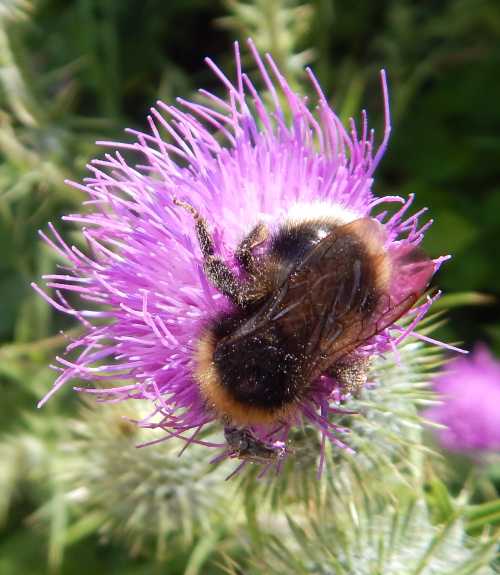 Bumble bee foraging on spear thistle - Cirsium vulgare.
Bumble bee foraging on spear thistle - Cirsium vulgare.In my neighbourhood and near by, the thistle species I mostly see are spear thistle, creeping thistle and slender thistle.
The creeping thistle is especially abundant, and attracts many species of bumble bees and solitary species, moths, flies and beetles.
Species Of Thistle
Here are some of the common species of thistle you may see out and about in the countryside.
Spear thistle - Cirsium vulgare
When people think of thistles, usually the spear thistle springs to mind first, with its large, spikey purple flower heads. It's a common species, and when in flower, you're sure to see bees, hover flies, various beetles and butterflies or moths feeding on them.
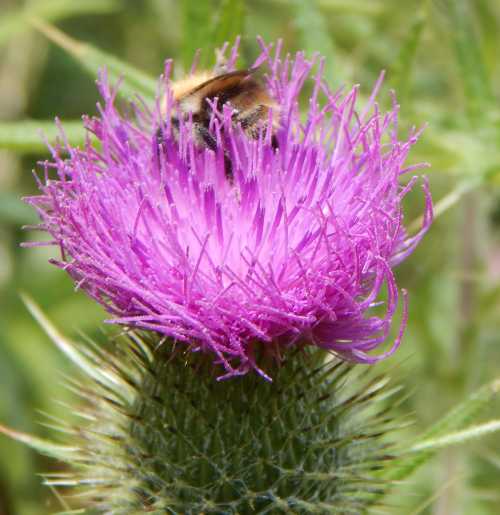 Common carder bumble bee Bombus pascuorum on spear thistle Cirsium vulgare.
Common carder bumble bee Bombus pascuorum on spear thistle Cirsium vulgare.These thistles are tall and stout, with spikey stems.
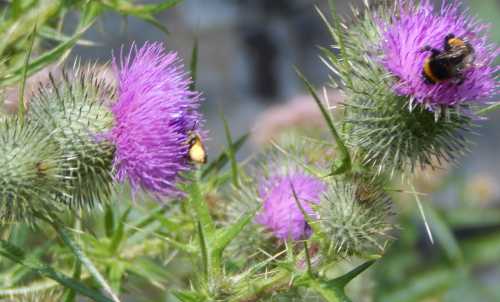 Bumble bee (right) and leafcutter bee (left) on spear thistle - Cirsium vulgare.
Bumble bee (right) and leafcutter bee (left) on spear thistle - Cirsium vulgare.An interesting feature of spear thistle is the 'cobweb'-like threads around the spines, which are tipped a brownish-yellow.
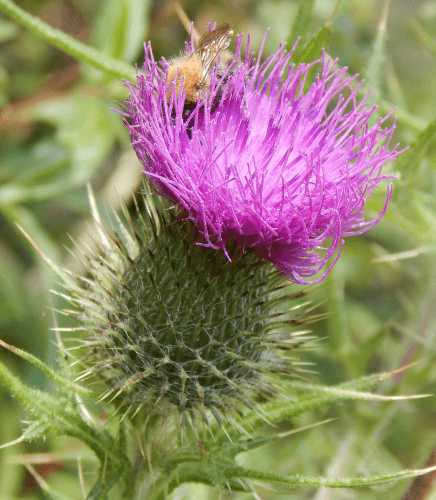 The spear thistle has cobweb-like threads around the spines of the flower head.
The spear thistle has cobweb-like threads around the spines of the flower head.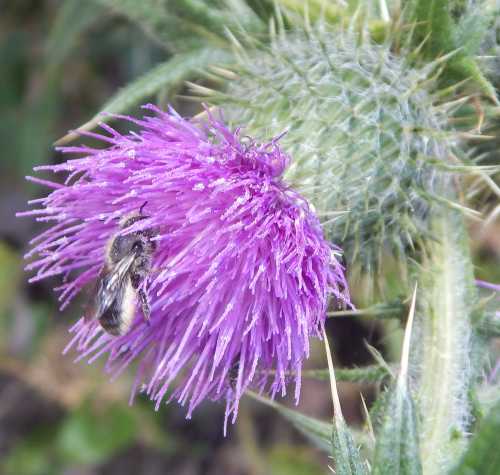 Leafcutter bee on spear thistle - Cirsium vulgare.
Leafcutter bee on spear thistle - Cirsium vulgare.
Creeping thistle - Cirsium arvense
In my experience, this lilac-flowered thistle seems to grow just about anywhere. Hence, it is not so popular with farmers! However, on a wild verge, again it will attract an abundance of bees, flies, beetles and other invertebrates.
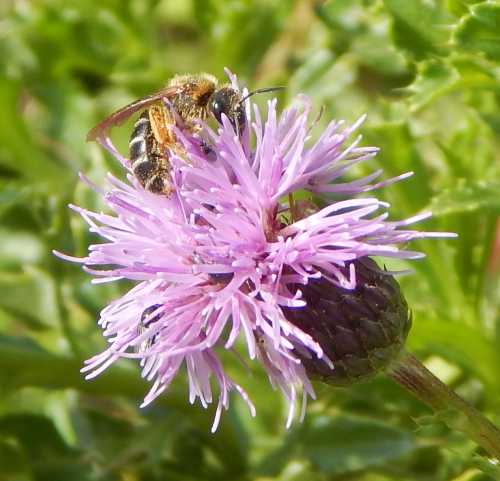 Orange-legged furrow bee Halictus rubicundus on creeping thistle - Cirsium arvense.
Orange-legged furrow bee Halictus rubicundus on creeping thistle - Cirsium arvense.I especially love to look out for the striking burnet moths that visit the creeping thistles growing on scrubby coastland close to my home.
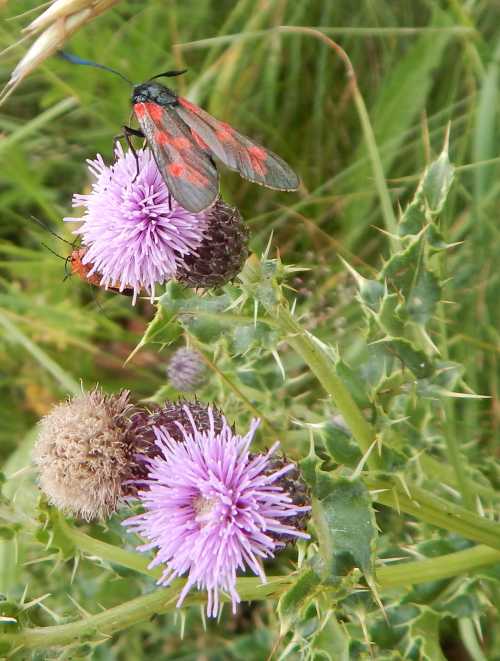 Burnet moth on creeping thistle Cirsium arvense.
Burnet moth on creeping thistle Cirsium arvense.The burnet moths often share the flower heads with red soldier beetles, as well as bees!
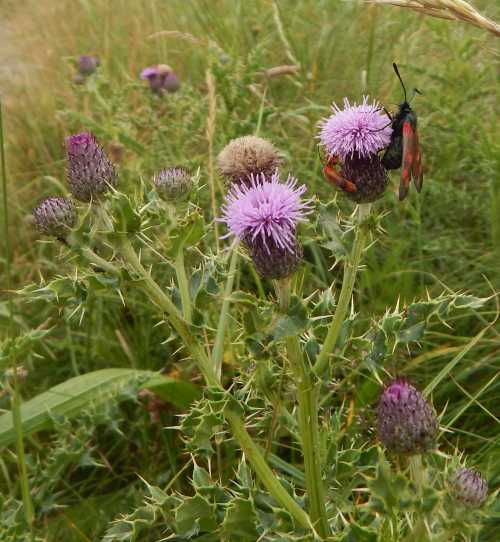 Common red soldier beetle and burnet moth on creeping thistle - Cirsium arvense.
Common red soldier beetle and burnet moth on creeping thistle - Cirsium arvense.The flower heads are not so prickly as the spear thistle, nevertheless, this tall, slender thistle certainly has prickly leaves and stem.
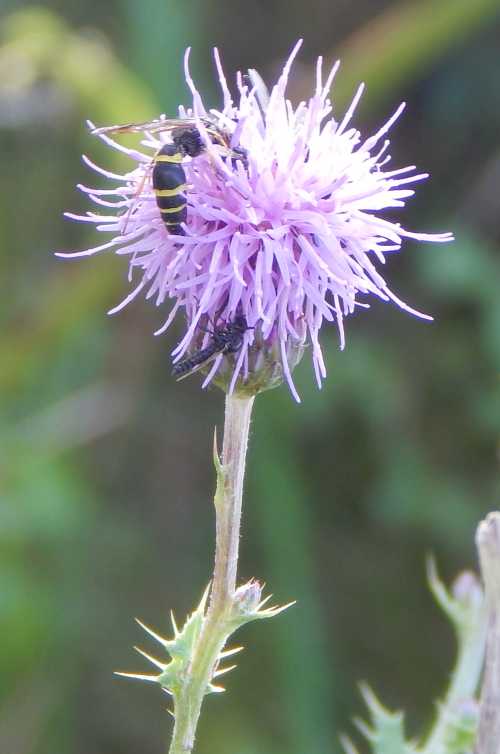 Field digger wasp on creeping thistle - Cirsium arvense (black fly unidentified).
Field digger wasp on creeping thistle - Cirsium arvense (black fly unidentified).Look out for species of wasp too, such as the Field digger wasp (above).
Bees and slender thistle - Carduus tenuiflorus
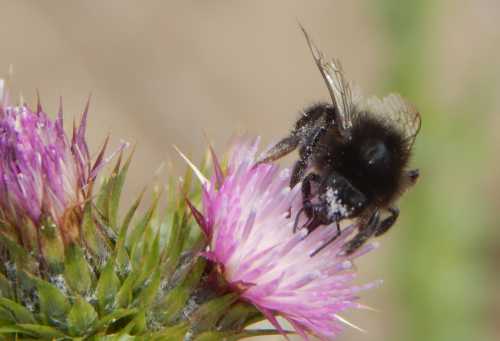 Bumble bee on slender thistle - Carduus tenuiflorus.
Bumble bee on slender thistle - Carduus tenuiflorus.Slender thistle is another lilac-flowered species, however, unlike the creeping thistle, it has groups of bunched-up flowers at the tops of the stems. Coastal areas are favoured by this thistle, and indeed, it grows around the sandy coastal dunes in my region, where it provides food for a variety of foraging bees.
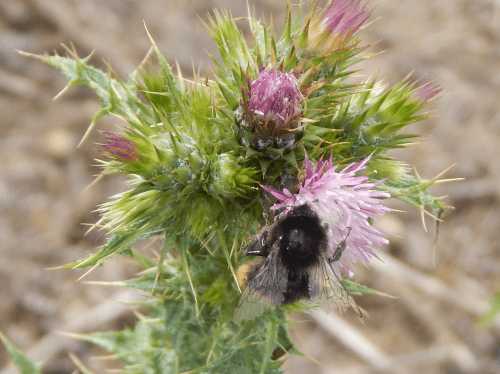 Bumble bee on slender thistle - Carduus tenuiflorus - this species of thistle has groups of bunched-up flowers at the tops of the stems.
Bumble bee on slender thistle - Carduus tenuiflorus - this species of thistle has groups of bunched-up flowers at the tops of the stems.It is a very prickly plant (- so watch out if you are wearing open-toed sandals and shorts or a skirt), and again, on close inspection, fine strands of cobweb-like threads are visible around the spines.
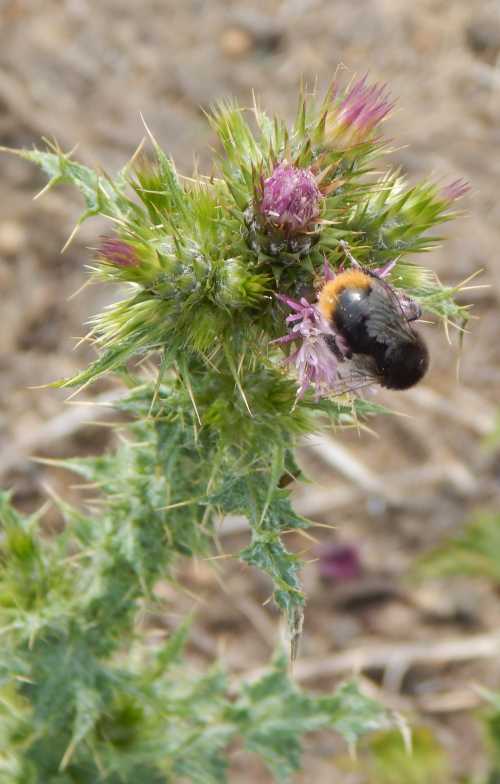 The prickly stems and leaves cause no bother for bees, but look out if you are wearing shorts and sandals!
The prickly stems and leaves cause no bother for bees, but look out if you are wearing shorts and sandals!Even when the bees have gone, at the end of the flowering season, the flower heads of thistles develop fluffy seed heads, which may also attract grateful birds.
If you found this page helpful or interesting, I'd really be grateful if you would share it with others - if not this page, perhaps another, such as Gardening For Bees.
Thank you so much :) .